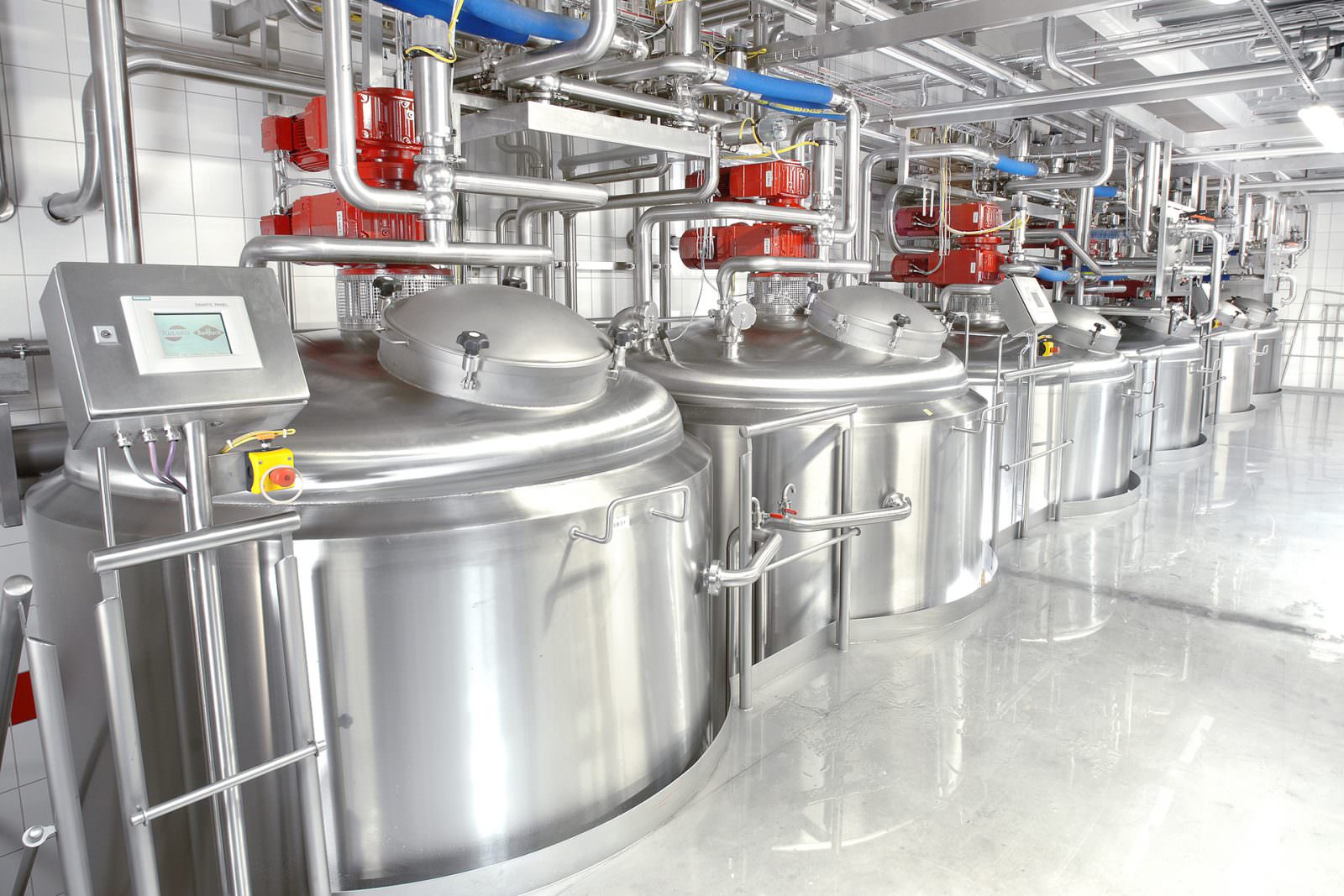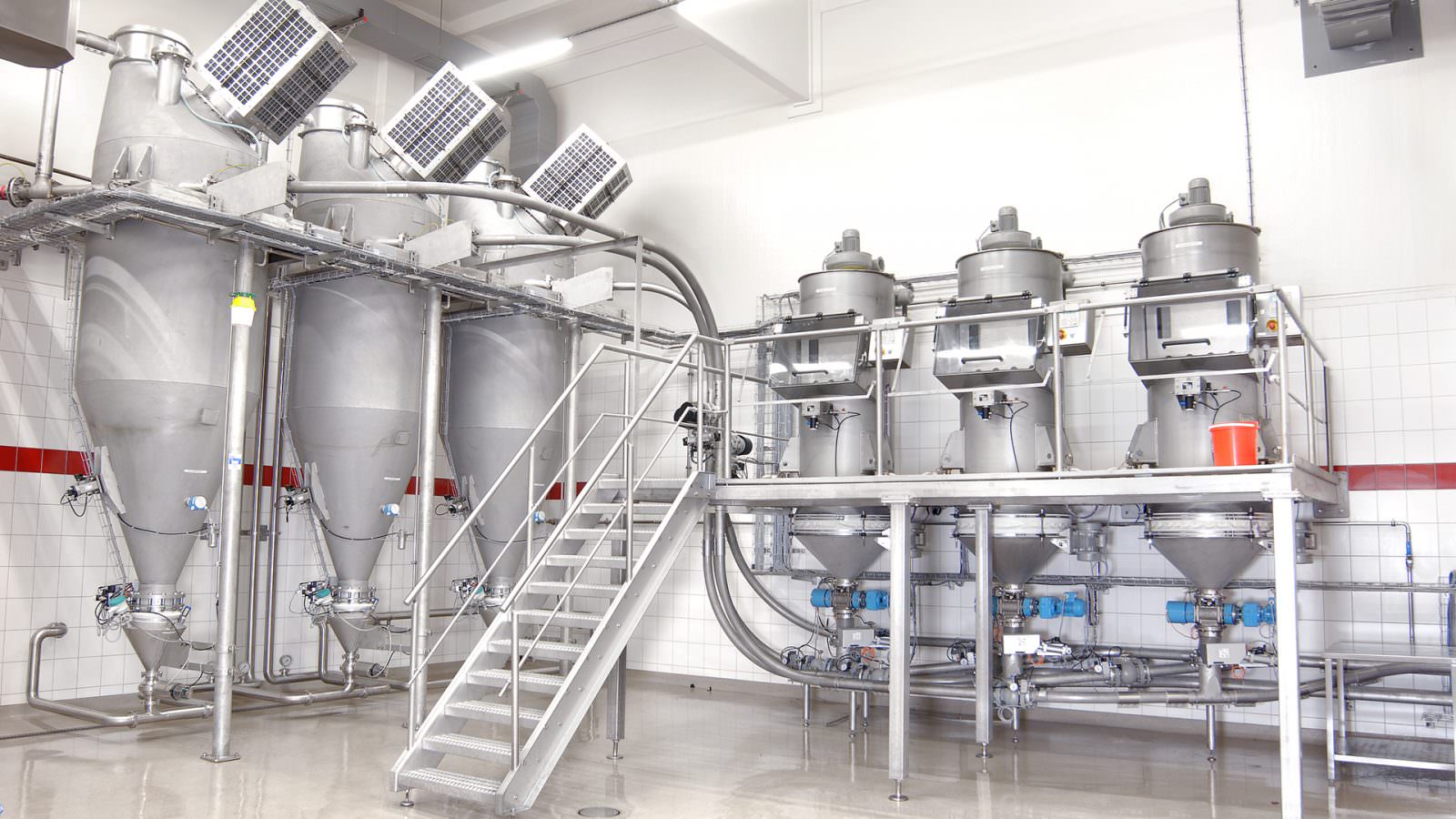

Mixing Systems
Dosing and Mixing for a perfect quality without losses
Mixing systems to mix foods, liquids and other products with quality standards: This depends on the exact dosing and the perfect preparation of solids because even minor deviations or undissolved particles will undermine the quality. Apart from classical systems for mixing and dosing raw materials, we also develop fully automatic mixers for batch mixing or continuous operation. We develop the software for administering raw materials, formulations and storage in-house: It is done by experts, who know exactly what is needed.
Homogeniser
Better texture and viscosity for liquids thanks to homogenisation
While producing, drying agents are often added to the liquids. These drying agents are dispersed at the tank with the help of agitators. Inline-dispersers automatically absorb and disperse these drying agents.
For a very fine dispersion oft he the ingredients with the result of a homogenous liquid, we use systems for homogenisation. These homogenisers minimise the particles of the liquid under pressure and ensure an even distribuition of the ingredients. Depending on the appliction and requirement, we use the homogenisers at the cold or hot product stream and at the aseptic area.
Our portfolio of “Dosing and Mixing”:
Batch mixing systems / Continuous mixing systems / Mobile mixing systems / Mixing systems for foods / Mixing systems for liquids / Mixing systems for aromas / Mixing systems for pharmaceutical or chemical products / Dosing systems / Systems for dissolving solids / Homogenisers / Dispersers / Software for management of raw materials, formulation and storage
Dosage
Precise dosing ensures constant product quality
Weight
Flow rate
Mass flow
Small or large weighing containers are used for gravimetrical dosage or registration of the weight for quality control, process monitoring or documentation. We provide the weighing containers with weighing cells in hygienic design.
The liquids are dosed with magnetic-inductive or mass flow meters, according to their accuracy requirement or their chemical-physical characteristics. There are two possibilities for the process. Either, the dosage takes place during a batch process at the container. Or at a steady procedure for dosing and mixing. This procedure merges various product streams, that are online volume- or mass controlled, to one main stream that is homogenised via static mixers.
Direct steam injection
How you can improve the quality of your products via direct steam injection and to reduce additives at the same time.
Juices, yoghurts, jams and many more: A lot of foods contain colouring and flavouring agents. And in the case of pasteurised products, e. g. fruit preparations, these agents are often added to the raw product batch. Although the additives only have a minimal microbiological basic load, there exists the danger of re-contamination if they are added after the pasteurisation. Furthermore, there is a disadvantage associated with this method as the additives are subject to the same technical process as the raw product batch and as a consequence suffer from thermal load during heating. On the one hand, this leads to a reduction in quality while on the other hand the manufacturer needs to dose in exceedingly large quantities in order to achieve the desired results.
Possible alternatives such as sterile filtration fail, because in the case of colouring and flavouring agents filters are not suitable due to spreading. A definitive assignment of filters is mainly impossible as a result of the wide variety of products and their additives. The Ruland dosing station for colouring and flavouring agents was developed to ensure a high level of quality in the production process. Thanks to a direct steam injection, the dosing station is able to guarantee a minimum thermal short term load of the additives. This approach means that Ruland can provide a method that enables our customers to improve quality whilst simultaneously reducing the quantity.
Technical approach
The precondition for the application of this technology in food production is that the finished product allows the presence of water or condensate respectively. This is because for the quantity to be heated, approximately 2 % condensate is generated per 10 °C heating.
When applying this method of colour and flavour dosage, the additives are filled into a container and heated up to the respective temperature within a split second. This is achieved by means of an injection system that is fed with culinary steam. This method means that a temperature change of approximately 70 °C is possible within just one run. Therefore, with a starting temperature of 20 °C, a pasteurisation temperature of 90 °C can be reached immediately. If higher temperatures are necessary, the colouring and flavouring agents are preheated up to 50 °C prior to the temperature change. Following this, the additives are directly injected into the cold, aseptic product via an aseptic transfer line. This results in an immediate cooling down of the additives to a temperature below the critical level. An additional heat retention time can be generated by the length of the transfer line.
The dosing station is fully automated and flow meters accurately monitor the volume flows. As many flavouring agents cannot be measured inductively, mass flow meters are used for colour and flavour dosage. Depending on the type of additives used, the ATEX requirements are also met.
With all of these characteristics, the dosing station for colouring and flavouring agents provides all users with another element to ensure a gentle production process. This advantage is combined with a cost-effective use of product ingredients as well as a high level of product quality.
Do you want to learn more about our systems for dosing and mixing?
We would be delighted to advise you personally!
More on unlimited possibilities for mixing and dosing systems.
